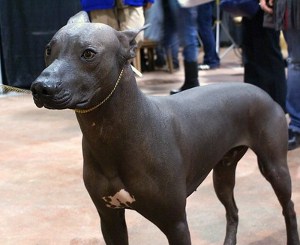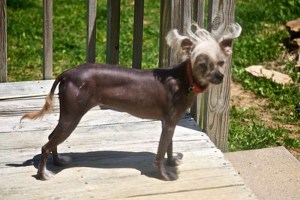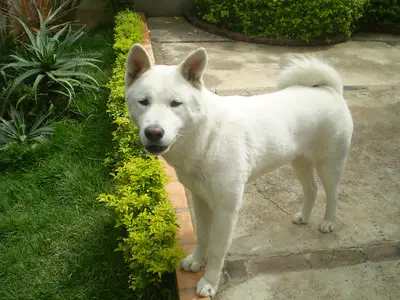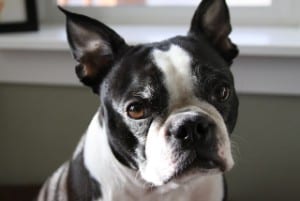
If you have a dog with black fur, have you ever seen it shaved? Is its skin as black as its coat? You might already know this, but some dogs do have naturally black skin.
That’s normal, but sometimes, dogs that don’t have black skin can develop them. This might be a sign of Black Skin Disease, which isn’t as bad as you think.
OK, before we get into any of that, let’s take a look at why some dogs have black skin.
Black Skin Is Natural In Dogs
In dogs, and nearly every animal (yes, including you), there are cells that produce melanin, the pigment which, for all intents and purposes, define the color of their skin, fur and eyes. For dogs in particular, there are two main pigments, but we’ll only look at the one called Eumelanin.
It is, by default, black and depending on your dog’s genetics the amount of Eumelanin they have can define how light or dark your dog is. So, it’s normal for some dogs to have black skin and black fur.
So, It’s Normal For Dogs With Black Fur To Have Black Skin?
Well, yes and no. If you’ve shaved your dog before, and you’ve seen their skin, you’ll know that not all black-haired dogs have black skin. Those with light skin, simply don’t have enough eumelanin in their skin. It just means, the Eumelanin is only going into the fur.
Some dogs might also have a mix of black and light pigments in both their fur and skin. So, don’t always assume that if your dog has black fur, it has black skin. Of course, sometimes, that’s not the case, and the black skin they have is not normal. This is where Black Skin Disease comes in.
What Is Black Skin Disease? Is It Dangerous?
First off, no. Normally, Black Skin Disease isn’t dangerous. It occurs naturally in some breeds and is more prevalent in males than females. For the most part Black Skin Disease doesn’t harm your dog; it doesn’t cause irritations or itching, but it does raise concerns, when you decide to start breeding.
Basically, if your dog does have Black Skin Disease, they’re more susceptible to sunburn or frost bite, because the hairs in their coat will be thin or cottony, and they could have bald patches. It also causes hyperpigmentation in their skin, thus the reason it’s called Black Skin Disease. You should also remember that symptoms might not show until after they’re 2 years old. So, it’ll be very tricky if you’re a breeder, since you’ll want to breed your dogs when they’re about 1 year old.
What Causes Black Skin Disease?
No one really knows, but generally it’s believed to be caused by allergies, hormone imbalances, obesity and genetics. Regardless, the best way to prevent its spread is to study the dog’s bloodline for any history of Black Skin Disease, before you get it neutered.
If you don’t know the dog’s history, it’s always a good idea to check with your local veterinarian and get them tested, to make sure that the black skin on your dog isn’t because of other illnesses. They use many different types of tests from physical examinations to blood tests, and skin scrapings, just to be sure you’re not dealing with something more malignant.
Can It Be Treated?
Not really. The only solution is to help them regrow their coat, so they don’t suffer the heat or cold. The best thing you can do for your dog is spaying or neutering it. It’ll help to regrow their coat, thanks to the hormonal changes after sterilization, but this isn’t a permanent solution.
You can give them hormone therapy, but this can be dangerous, not only for your dog, but for you as well, because the treatment includes a drug that can be toxic to their liver and cause an increase in aggression.
Another treatment you can try is oral melatonin therapy, which increases the production of melanin in your dog’s system. Be careful though, it’s not FDA approved, so you might be harming your dog more than helping them.
Essentially, speak to your local veterinarian, they’ll know what to do, and will prescribe various treatments to help with the regrowth process.
[1] Mexican Hairless Dog – Xoloitzcuintli
The Xoloitzcuintli, better known as the Mexican Hairless, is a breed of dogs that naturally have black or dark skin. Making it highly unlikely they’ll get Black Skin Disease.
It’s thanks to their environment, really. Living in a hot country like Mexico, having hair or fur would simply make these dogs overheat, so you don’t need to worry about grooming or shedding!
However, these dogs are very active, so be ready to start going for daily runs, or playing in the park, if you aren’t active yourself.
You’ll also need to pay attention to what they eat, because they require high quality food, and if they eat too many treats can easily become obese.
[2] American Hairless Terrier
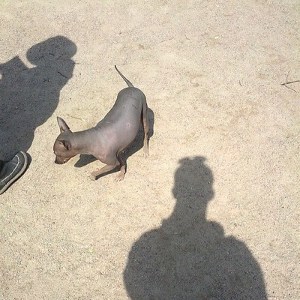
These dogs are another breed that has black skin or the potential for it. Again, because they’re hairless, they’re unlikely to get Black Skin Disease.
They’re also small, about 12-16 inches, so if you’ve got an apartment, they’ll be perfect for you!
These dogs don’t need much grooming, and you won’t have to worry about shedding, since they’re either hairless or their coat has short hairs.
However, they do need some moderate exercise, to keep them happy. Just a few minutes in a yard or a daily walk would suffice.
Of course, like the Xoloitzcuintli, you will need to watch their diet as they too are prone to obesity, if fed too much.
[3] Chinese Crested Dog
These tiny dogs are perfect for those who live in apartments.
They come in various different colors, including black, and they are usually characterized by their hair that look like they’d either come back from the hair salon or like those stereotypical old Chinese men.
These dogs do require high quality food, but be careful how much you give them, since they’re tiny and are prone to obesity.
You don’t have to worry too much about shedding, but because of their mane, you’ll probably find a few hairs on your furniture.
You also don’t have to worry about their exercise regime, since a short walk and a little bit of playtime is what these dogs love.
[4] Shar Pei
If you’ve seen a Shar Pei, you’ll know them by the wrinkles on their body. Normally these dogs have a tan coat, but you can also find them in black.
Of course, it isn’t always the case that they’ll have black skin under their coat, and it’s unlikely they’ll develop Black Skin Disease. Be careful though, these dogs can be stubborn.
While high quality dog food is recommended, it’s ok to give them scraps once in a while, just avoid feeding them too many foods with high fat content. They do shed quite a bit, so be ready to have furniture covered in short hairs. Their exercise needs vary, so just keep an eye on their personality, and you’ll know what they’ll need.
[5] Chow Chow
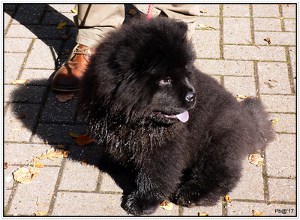
These breeds are one of those that are known to get Black Skin Disease, so be careful when you’re choosing your Chow Chow.
While they can have black coats, keep an eye on their appearance, just in case. These adorable fluffy pups are perfect for city life, and while they may be active, all they really need is a lot of playtime or a daily walk.
You don’t need to be as strict with their diet, like some other breeds but many owners choose to give them low grain diets. Just keep checking on them, to make sure they don’t have any allergies to their food. These dogs have full manes, like lions, so expect a lot of shedding and be prepared to brush them 2-3 times a week.
[6] Elkhounds
You can call these dogs miniature wolves, because that’s what they look like. Their gray and black coats are what make them look like wolves, but they’re just over 20 inches in height. These dogs are also susceptible to Black Skin Disease, so be careful when adopting one.
They’re very active, and will follow their nose, so be careful when going for a walk. They might just run off without a second glance. You’ll also find they’ll eat nearly everything in front of them, so watch their diet and don’t overfeed them.
[7] Pomeranian
Another susceptible breed is the Pomeranian. These adorable fluff balls come in all shapes and colors, including black. Their fur literally makes them look twice as big as they really are, so they embody the whole “tiny body, big personality”.
Be careful with these ones, they can slip through nearly everything, so keep them on the leash, if you do go out for walks. While they may be inquisitive, they can be a nightmare at home, so train them early to be obedient. You should also watch their diet and make sure clean water is available to them at all times.
Be Mindful
So, if you’re choosing to adopt a new dog, if you already have one, just be sure you know your dog’s bloodline, and whether or not they’re susceptible to getting Black Skin Disease, or if they’re naturally dark skinned. Always check with your local veterinarian, and get your dogs tested, in case your dog isn’t carrying anything more malignant.
If your dog does have Black Skin Disease, then the best thing to do for them is get them neutered or spayed, to help them regrow their coats, as well as prevent the disease’s spread. Finally, do your research. What you think might be malignant, might be nothing at all, and vice versa. So, make sure you know all the signs, and don’t panic. There are plenty of experts out there who can help, all you have to do is ask.

